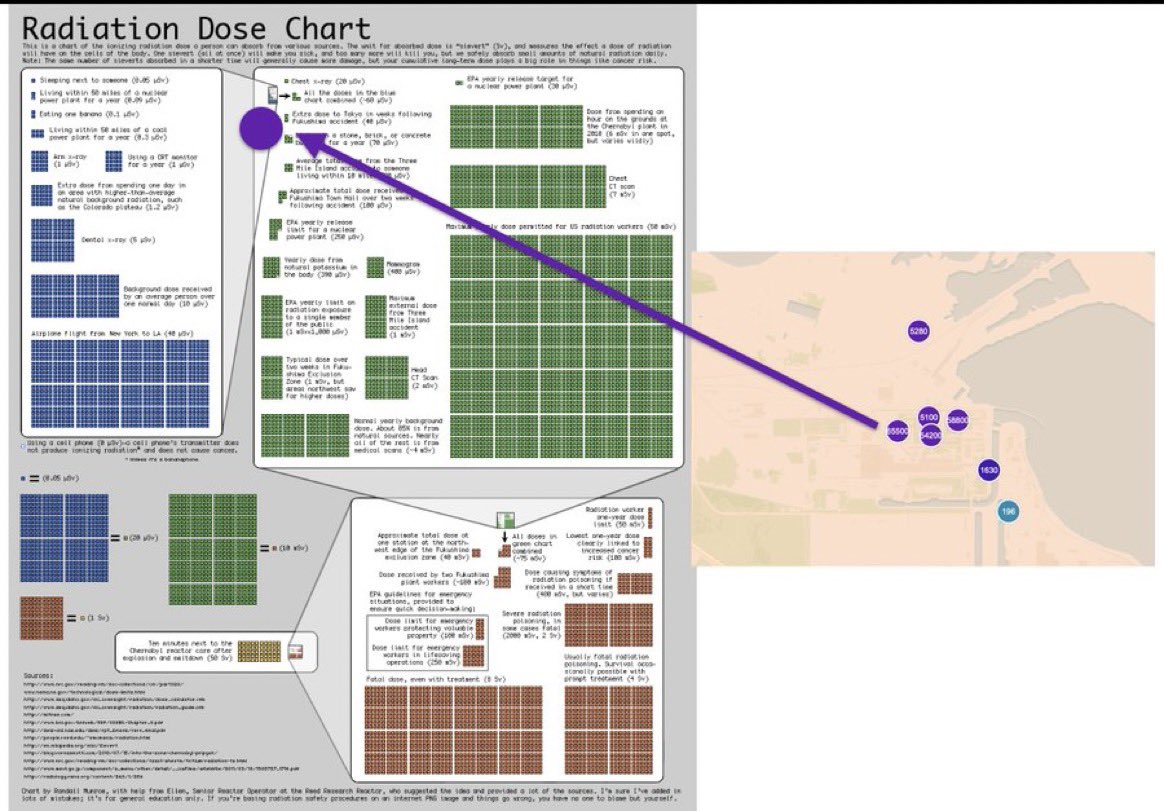WATCHING—elevated radiation ☢️ levels observed at #Chernobyl reactor site—not super high yet but 65 μSv (65k nSv) is elevated above normal. There was reported shelling around Chernobyl between Russian & Ukrainian forces. Praying this doesn’t get worse.🙏
saveecobot.com/en/radiation-m…



saveecobot.com/en/radiation-m…




2) the other adjacent detection sites with 58 micro-SV also show the spike today is new. Not a normal average reading. And this just happened because it just turned to Feb 25th local time. There was no spike on the 24. 

3) there are credible reports there is a hostage situation going on at Chernobyl. From @guardian.
theguardian.com/world/live/202…
theguardian.com/world/live/202…

4) The White House @PressSec says there are staff at Chernobyl 🇺🇦 plant being held hostage, says BBC.
https://twitter.com/bbcsarahsmith/status/1496985897258074119
5) UK confirms workers at Chernobyl have been “detained” by Russian troops.
https://twitter.com/DefenceHQ/status/1497015621082624003
6) Here is the helpful @xkcd Radiation Dose infographic chart. 55-65 micro-SV is more than a transcontinental flight from NY to LA (40) plus dental 🦷 X-ray of 5 plus normal one day background of 10. So it’s elevated but not that high yet. 🤞🏼
xkcd.com/radiation/
xkcd.com/radiation/

7) I’ve been checking out the website. It seems legitimate site dedicated to environmental monitoring in Ukraine with both an English and a Ukrainian language version. And it has legit partners. Welcome anyone double checking if they are legit. saveecobot.com/en 



8) UPDATE— just been personally told the Chernobyl situation is currently “classified”.
9) to be clear, nobody is threatening me. It was a long time friend who told me it’s currently classified when I asked if there’s any knowledge of the situation. So let’s wait and see how it shakes out. Praying for the detained workers. Praying for Ukraine 🇺🇦
10) UPDATE — Ukrainian Parliament confirms radiation levels are definitely going up in Chernobyl area.
https://twitter.com/ua_parliament/status/1497108007863435279
11) many of us scratching our heads why there is an increase in the radiation ☢️ levels — some suspect maybe Russian tanks and trucks disturbed the radioactive soil and caused them to become airborne. Hence there is some rise throughout the region, not just in the reactor zone. 

12) the radioactive dust particles being kicked up by Russian tanks (the attack group from Belarus, headed to Kyiv) is the possible cause of the radiation surge. Hopefully it will settle in the coming days? 🤞🏼
https://twitter.com/with__ukraine/status/1497184488467558401?s=21
13) the lingering question is that why is the spike larger in some areas but not in others. Some of the highest spikes over 50,000 nano-SV aren’t along the conventional roads. Maybe it’s wind patterns by chance. But let’s hopefully know more soon.
saveecobot.com/en/radiation-m…

saveecobot.com/en/radiation-m…


14) UPDATE 3– the radiation levels have spiked again in the central area near the Chernobyl reactor.
⚠️The readings are now 72-93 micro-SV. 👀 This is up from 55-65 just 12 hours ago.
⚠️The readings are now 72-93 micro-SV. 👀 This is up from 55-65 just 12 hours ago.

15) that said—while it certainly could be a dust plume, by now it should be more diffusely spread through the area. But it is not. For example in another nearby location, there is another new 60 micro-SV reading, all while areas to the west, south, east are low! Dust plume alone? 



16) to be clear, the old fuel in the sarcophagus is pretty safe according to nuclear experts, unless targeted. So far the radioactive dust particles kicked up by tanks likely best explanation. Question is why it dust plumes kicked up are so uneven. Let’s hope ☢️ drops soon.
https://twitter.com/clairecorkhill/status/1497159634188132352
• • •
Missing some Tweet in this thread? You can try to
force a refresh


















